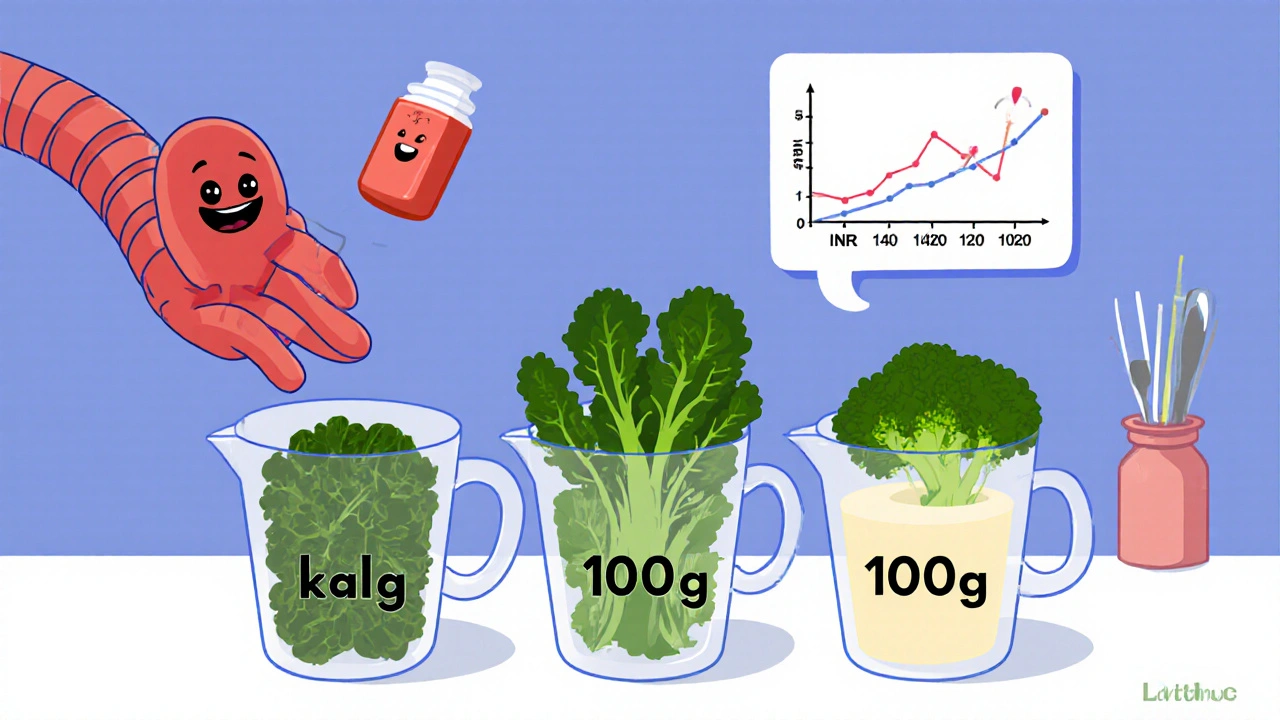Vitamin K Intake Calculator
How Much Vitamin K Are You Getting?
Calculate your daily vitamin K intake from common foods to help maintain stable INR levels while on warfarin therapy.
Estimated Vitamin K Intake
0.0 µg
Recommended range: 60-120 µg
Your intake is within the recommended range for stable INR.
When you're on warfarin, your life doesn't revolve around pills-it revolves around consistency. Not just taking your dose at the same time every day, but eating the same amount of vitamin K every day, too. It’s not about cutting out spinach or kale. It’s about making sure you don’t eat a huge bowl of kale on Monday and then zero greens for the rest of the week. That rollercoaster is what throws your INR off-and that’s when things get dangerous.
Why Vitamin K Matters More Than You Think
Warfarin works by blocking vitamin K from doing its job in your blood. Vitamin K helps make proteins that let your blood clot. Without enough vitamin K activity, your blood thins out. That’s good if you have a clotting risk like atrial fibrillation or a mechanical heart valve. But if your vitamin K intake jumps around, your INR does too.
Your INR is a number that tells your doctor how long it takes your blood to clot. Too low? You’re at risk for clots. Too high? You risk bleeding inside your brain or gut. The sweet spot for most people is between 2.0 and 3.0. For those with mechanical heart valves, it’s higher-2.5 to 3.5. But keeping it there isn’t just about the pill. It’s about what’s on your plate.
Research shows patients with inconsistent vitamin K intake are more than twice as likely to have INR levels outside the safe range. One study found that when people kept their vitamin K intake steady, their time in therapeutic range (TTR) jumped by nearly 15 percentage points. That’s not a small win. Every 10% increase in TTR means a 15% lower risk of stroke or major bleeding.
How Much Vitamin K Is Too Much-or Too Little?
The official daily recommendation for vitamin K is 90 micrograms for women and 120 for men. But that’s just a baseline. People on warfarin need more structure than that.
Most people in the U.S. already eat close to those numbers-about 93 µg for women, 122 µg for men. But the problem isn’t total intake. It’s variation. Eating 50 µg one day and 300 µg the next? That’s a problem. Eating 100 µg every day? That’s manageable.
Here’s what’s in common foods:
- 1 cup cooked spinach: 889 µg
- 1 cup raw kale: 547 µg
- ½ cup cooked broccoli: 102 µg
- 1 egg: 20 µg
- 3 oz chicken breast: 2 µg
That’s why doctors don’t tell you to avoid greens anymore. In fact, the American College of Chest Physicians says restricting vitamin K is not just useless-it can be harmful. People who cut out leafy greens often develop a hidden deficiency that makes their INR even more unstable.
Instead, the advice now is simple: eat vitamin K-rich foods regularly, but keep the amount steady. A good target range is 60-120 µg per day. That doesn’t mean you have to eat exactly the same thing every day. It means if you have a big serving of spinach on Tuesday, don’t have another big one on Wednesday. Space it out. Balance it.
What Happens When You Change Your Diet?
Imagine you’ve been eating one cup of mixed greens three times a week. Your INR is steady. Then you go on a juice cleanse and drink three kale smoothies a day for a week. Your INR might drop below 2.0. You feel fine. But if you suddenly stop the smoothies? Your INR could spike to 5.0. That’s a bleeding risk.
Or think of it this way: your body builds up a tolerance to the amount of vitamin K you eat. If you eat a lot one week, your body adjusts. Then you cut back. Now your blood is too thin. It’s not the food itself-it’s the swing.
Studies back this up. One landmark trial gave patients 150 µg of vitamin K daily as a supplement-and saw their time in range improve from 58% to 66%. No extra bleeding. Just better control. Another study found that patients who got personalized dietary advice from a pharmacist hit 82% TTR. Those who didn’t? Only 63%.
And it’s not just about leafy greens. Vitamin K is also in natto (fermented soy), liver, and some cheeses. But most people get their K1 from vegetables. That’s what matters most for warfarin.

How to Track Your Intake Without Going Crazy
You don’t need to weigh every spinach leaf. But you do need to be smart about it.
Start with a food diary for the first four to six weeks. Use a simple app like Warframate (available on iOS and Android), which has a database of over 1,200 foods with vitamin K values pulled from USDA data. Or just write it down in a notebook.
Here’s a sample day that hits around 120 µg:
- Breakfast: 1 scrambled egg (20 µg)
- Lunch: ½ cup cooked broccoli (102 µg)
- Dinner: 3 oz chicken with 1 tbsp olive oil (2 µg)
That’s 124 µg. Easy. And you can swap the broccoli for 1 cup of raw kale or a small spinach salad-just don’t do all three in one day.
Use measuring cups. Don’t guess. Research shows people who estimate portion sizes get vitamin K intake wrong by up to 45%. A cup of spinach looks like a handful. But it’s not. A cup is the size of a baseball. Measure it once. Then you’ll know what it looks like.
Some clinics use a “Vitamin K Consistency Calculator” that gives you weekly templates. One week you might have spinach on Monday and broccoli on Thursday. The next week, you switch-same amounts, just swapped. That’s consistency.
Genetics and Individual Differences
Not everyone responds the same way. Some people are naturally more sensitive to vitamin K because of their genes. If you have a variant in the VKORC1 or CYP2C9 gene, even small changes in your diet can swing your INR.
Doctors don’t routinely test for these genes-but if your INR is wild and nothing else explains it, ask. One study found that people with certain gene variants need to keep vitamin K intake within ±10% variation to stay stable. Others can handle ±25%.
And even with perfect diet control, 15-30% of INR changes still have no clear cause. That’s why regular blood tests are non-negotiable. Your doctor needs to see the trend over time, not just one number.
What to Do If Your INR Is Off
If your INR is too high or too low, don’t panic. Don’t suddenly stop eating greens or start taking vitamin K supplements on your own.
Call your anticoagulation clinic or pharmacist. They’ll ask you: “What did you eat differently in the last week?” That’s the first question. Not “Did you miss a pill?”-because it’s usually not the pill.
If you’ve had a recent change-travel, illness, new diet, holiday feast-that’s your clue. Go back to your baseline. Stick to your usual portions. Wait a few days. Retest.
Emergency visits for INR issues are common in the first year on warfarin. In one survey, 31% of patients went to the ER. In 57% of those cases, inconsistent vitamin K intake was the main reason.
But here’s the good news: when patients get proper counseling, those numbers drop fast. One program reduced ER visits by 28% just by teaching people how to eat consistently.

What You Should Never Do
- Don’t stop eating leafy greens. They’re full of fiber, vitamins, and antioxidants. Cutting them out hurts more than it helps.
- Don’t take vitamin K supplements without talking to your provider. Even 100 µg daily can interfere with your dose.
- Don’t rely on memory. Write it down or use an app for the first month.
- Don’t assume all greens are equal. A cup of spinach has 10x more vitamin K than a cup of lettuce.
Real People, Real Results
One Reddit user, u/WarfarinWarrior, shared how their INR swung between 1.5 and 4.5 for months. Then their pharmacist gave them a simple chart: eat 1 cup of mixed greens every Tuesday and Thursday. Nothing else. Within two months, their TTR jumped from 45% to 78%.
Another patient, a retired teacher in Cambridge, started tracking her meals with a food diary. She used a measuring cup for her kale. She stopped worrying about “good” or “bad” foods. She just made sure her Tuesday and Friday salads were the same size. Her INR hasn’t been out of range in over a year.
This isn’t about perfection. It’s about predictability. Your body likes routine. Your blood clotting system likes routine. Warfarin works best when your diet doesn’t surprise it.
Final Takeaway
Warfarin isn’t a drug you take and forget. It’s a partnership-with your doctor, your pharmacist, and your plate. You don’t need to eat perfectly. You need to eat consistently.
Focus on this: Same amount of vitamin K, most days. Don’t restrict. Don’t overdo. Just keep it steady. That’s how you stay safe, avoid hospital visits, and live well on warfarin.
Can I eat spinach if I’m on warfarin?
Yes, you can-and you should. Spinach is high in vitamin K, but that’s not a reason to avoid it. The key is to eat about the same amount most days. If you normally eat one cup of spinach twice a week, keep doing that. Don’t suddenly eat three cups one day and none the next. Consistency beats restriction.
Does vitamin K interact with other blood thinners?
No, only warfarin is affected by vitamin K. Newer blood thinners like apixaban (Eliquis), rivaroxaban (Xarelto), and dabigatran (Pradaxa) work differently and don’t rely on the vitamin K pathway. So if you’re on one of those, you don’t need to track your greens. But if you’re on warfarin, vitamin K matters.
How long does it take for vitamin K to affect my INR?
It usually takes 2-5 days for a change in vitamin K intake to show up in your INR. That’s why you can’t just skip a meal and expect your number to change tomorrow. That’s also why tracking over a week gives you better insight than a single day.
Should I take a vitamin K supplement to stabilize my INR?
Only if your doctor or pharmacist recommends it. Some unstable patients benefit from a daily 150 µg supplement, but it’s not for everyone. Self-supplementing can make your INR harder to predict. Always talk to your care team first.
Can alcohol affect my INR when I’m on warfarin?
Yes. Heavy drinking (more than 3 drinks a day) can increase your INR and raise bleeding risk. Even moderate drinking can interfere with how your liver processes warfarin. The safest approach is to keep alcohol intake consistent-if you drink, do it the same amount each week. Avoid binge drinking entirely.
What should I do before surgery or a dental procedure?
Never stop warfarin on your own. Always tell your surgeon or dentist you’re on warfarin. Your anticoagulation team will decide whether to adjust your dose, hold it temporarily, or proceed with your INR checked on the day of the procedure. Most dental work can be done safely without stopping warfarin if your INR is under control.
How often should I get my INR checked?
When you first start warfarin, you may need checks every few days. Once stable, most people test every 2-4 weeks. If your diet changes, you get sick, or start a new medication, you may need more frequent testing until your INR settles again. Always follow your clinic’s schedule.
 Nov, 24 2025
Nov, 24 2025
